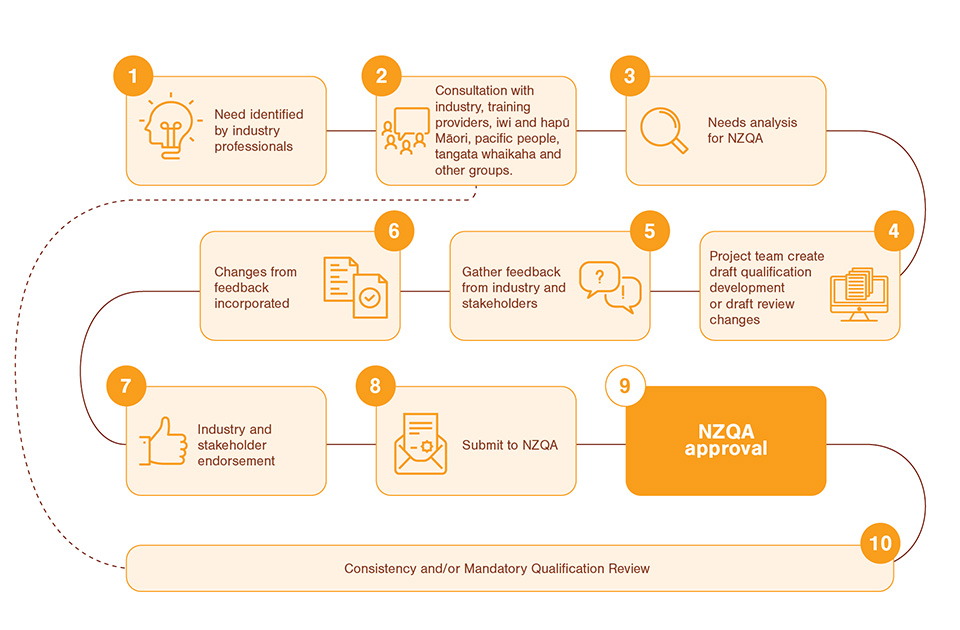
The process for developing and reviewing the qualifications, standards, and microcredentials in the vocational sector is a straightforward one.
The diagram above gives a good idea of how it is done, but it may be helpful to have a little more explanation.
A need for a vocational education product is identified by industry professionals. This could be due to a need to upskill staff quickly, for staff to learn new technology, to take account of legislative changes, or any other need that industry representatives identify as necessary for their workplaces.
Ringa Hora’s role is to see if there is a product that is already on the framework which could address these needs, or if not, to discuss opportunities to develop such a product. Ringa Hora will also take into account the findings of its documents such as Workforce Development Plans (WDPs) and Industry Action Plans (IAPs) if they are in line with industry priorities.
Priorities are decided in a number of ways. It could be incorporated as part of a 5-year scheduled review of vocational education products, or Ringa Hora could identify who has capacity to take this on. Qualifications professionals at Ringa Hora would also look to see how ready industry are to develop.
Consultation starts with the Ringa Hora Partnership and Engagement team, which gets in touch with industry representatives. Training providers are also contacted, while we also seek input from iwi and Māori organisations, tangata whaikaha, Pacific Peoples organisations, and other relevant groups.
If a review or development of an education product is being held, Ringa Hora advertises this on its website and social media networks, and calls for expressions of interest. Once these expressions of interest are received, we schedule a meet and greet.
The meet and greet sets the scene of what the project entails. It is also a chance to share any survey results, workforce insights, introduce skill standards and micro-credentials. More importantly, it is a chance for the sector to come together and share their insights.
After the meet and greet, a working group made up of industry and provider representatives is formed to put the product together. To find more about working groups and what is expected of them, please visit this page.
The needs analysis is only done for new qualifications or microcredentials. If a new product is desired, we need to contact the New Zealand Qualifications Authority (NZQA) to explain why this is needed.
At this stage, the working group gathers to put together the product.
Ringa Hora’s role in the process is to facilitate the review and/or development. We work with industry, providers, and any relevant regulators to translate needs of industry and product requirements before it is evaluated and registered on the New Zealand Qualifications and Credentials Framework (NZQCF). We manage communications with NZQA and see the project from initial stage right through to registration on the NZQCF.
Once the initial development is complete, a draft product is released.
Industry and stakeholder feedback begins during Step 4, as working group members seek feedback from within their contact networks about the proposed product.
Once the draft product is ready, feedback is sought from industry representatives, education providers, and other relevant parties. We contact those who have indicated interest in being part of a consultation group, and arrange feedback sessions, which may be face-to-face, online, email communications, or phone conversations. The working group would establish this with the Ringa Hora Qualifications Development Facilitator to discuss preferred ways of working.
Once received, the feedback provided in Step 5 is considered by the working group and incorporated into the product.
Industry endorsement is from industry stakeholders, peak bodies, providers. It may be those who have been actively involved in the working group, the consultation group, and their networks.
Endorsement is provided via a Stakeholder Attestation form, which is available on the NZQA website.
This should also be available once the drafts are ready for national consultation.
This step is needed for qualifications and reviews, but not for standards.
Once stakeholder endorsements have been made, the product is handed to NZQA for its consideration.
An NZQA evaluator then has 20 working days to pick this up. The evaluator then has 20 working days to respond with an RFI (Request for Information) from the Qualification Development Facilitator (QDF). If this is made, the QDF then has 20 working days to respond to evaluator. Then it becomes an iterative process until it is fit to be registered on the New Zealand Qualifications and Credentials Framework.
If NZQA is satisfied with the product, it gives its approval. The product is now ready for providers to put together a programme to deliver.
If it is a review, the previous version remains current until the last date of assessment as indicated on the previous version. This is normally two years. Industry and providers should then work together so that a provider can deliver to a programme that meets the needs of industry.
The product will, every five years, be reviewed to ensure graduates are meeting requirements, to check if it is still fit for purpose, or if it requires amendment.